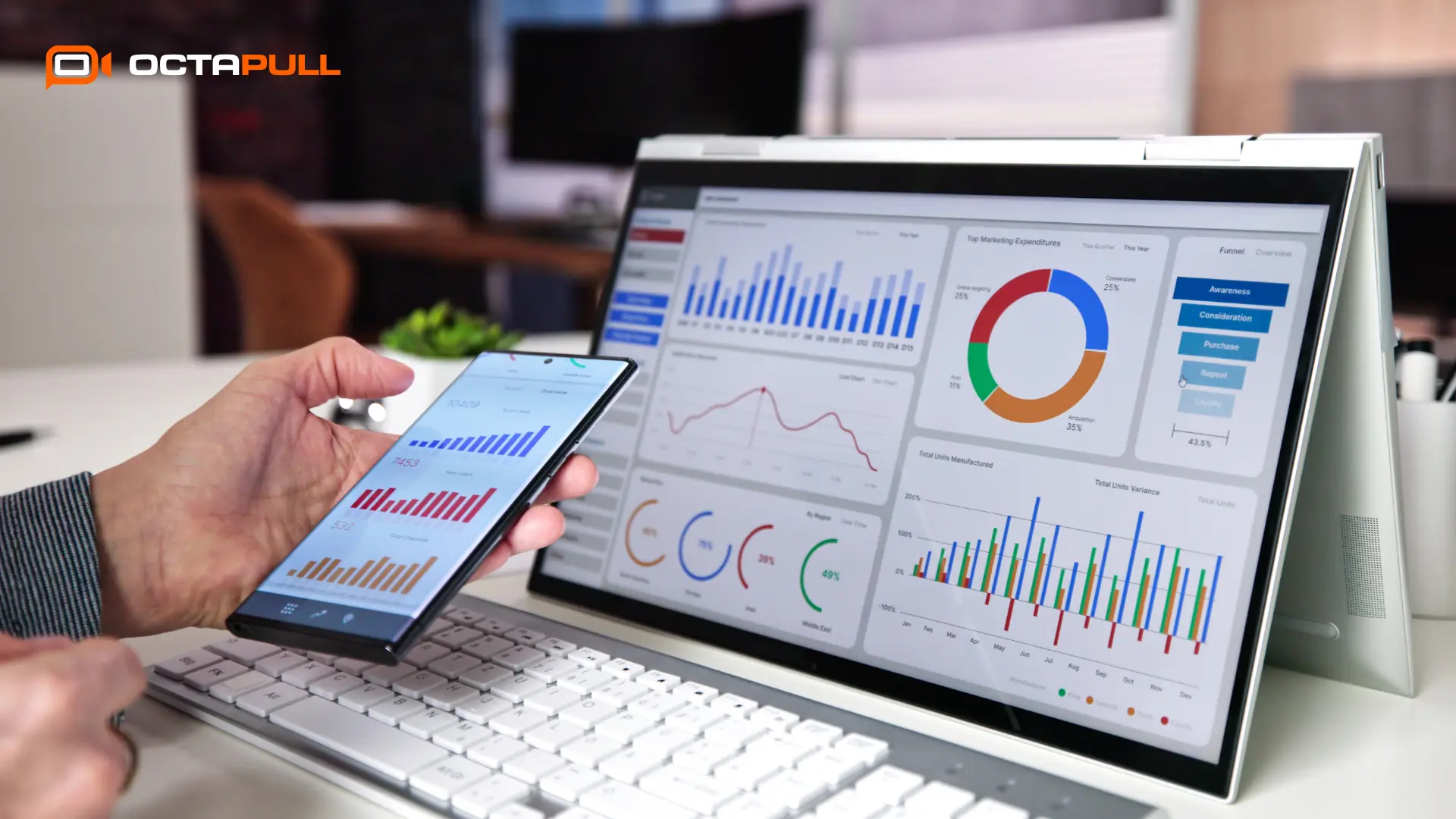In today’s business world, measuring performance is not just an advantage; it is a fundamental requirement for survival and growth. All strategic decisions and operational initiatives must be measurable to ensure the continuous progress of your organization.
However, when faced with extensive data, how can you identify the insights that will truly contribute to your success? In such cases, the implementation of Key Performance Indicators (KPIs) is an effective solution.
Key performance indicators play a pivotal role in directing businesses towards their overarching goals. In this blog post, we will examine the critical importance of KPIs and guide on choosing the most effective ones that align seamlessly with your business strategy.
What Are KPIs?
So, what is a KPI at a basic level? A KPI is a measurable metric that shows precisely how effectively a company is achieving its predetermined business objectives.
These statistics represent the most critical data points that offer deep insights into the overall health and strategic trajectory of your organizational goals. It is possible to evaluate them as vital signs of your business and to check whether your operations are improving.
The significance of key performance indicators serves as an effective communication tool, uniting both teams in particular and all individuals around common goals. KPIs ensure that every team member has a clear understanding of the criteria for success.
Why are KPIs Important For Your Business?
In what ways are KPIs important for businesses? An effective key performance indicator strategy is based on establishing an unbreakable link between the company’s numerical values and overall business strategy.
Without this crucial alignment, there is a significant risk of measuring activities that make no real contribution to your core mission. Such misalignment can lead to wasted resources and misdirected efforts.
This is why well-defined KPIs for setting goals empower businesses to consistently make data-driven decisions, optimize their operational processes, dramatically improve overall productivity growth, and achieve sustainable success.
Key performance indicators provide the necessary visibility to monitor ongoing progress and strategically capitalize on emerging opportunities. This approach will enable you to make decisive progress towards achieving the strategic objectives of your business.
KPIs should ultimately reflect what matters most to your organization in terms of its long-term vitality, growth, and sustainable prosperity.
Moving Beyond Metrics: The Art of Choosing the Right KPIs
It is important to understand that while almost every activity in a business can generate business metrics, not all metrics automatically qualify as KPIs. The key distinction lies in their direct strategic relevance and ability to inform key decisions.
1. KPI Should Align with Your Goals
KPI is, by definition, a strategic metric that is inextricably linked to a specific business objective and allows you to answer critical questions about your progress.
For instance, while “website visitors” is a measurable metric, “conversion rate from website visitors to customers” is a much more effective key performance indicator for a growth-oriented business because it directly reflects a desired outcome.
The selection of the appropriate KPI is a rigorous process that involves introspection and unwavering strategic alignment. Firstly, it is essential to define your overarching organizational goals with precision.
What are your primary goals? Is it to increase revenue streams, improve overall customer experience, optimize operational efficiency, or capture a larger share of the market?
The KPIs selected should serve as direct, measurable reflections of these high-level goals, providing clear insight into their achievement. Following the goal definition, consider specific results or key activities that will signal progress towards these set goals.
2. SMART Rule
Effective KPIs are based on the SMART framework: Specific, Measurable, Attainable, Relevant, and Time-bound.
For example, “Achieve a 20% reduction in customer support resolution time by the end of Q3” is a solid SMART KPI and provides a clear target, a measurable metric, and a precise timeframe for comprehensive business performance measurement.
It is equally vital to actively engage all relevant stakeholders throughout the key performance indicators decision process. Including input from sales, marketing, operations, and customer service teams is crucial to ensure that you are not setting KPIs that cover your entire company.
3. Identifying Too Many KPIs
It is also important to avoid the common pitfall of trying to track too many KPIs. This common mistake can result in teams being overwhelmed by an unmanageable volume of data.
Instead, the focus should be on identifying key performance indicators that drive effective decision-making and accurately reflect key performance, typically ranging from 5 to 10 per key strategic area.
Ultimately, it is essential to prioritise quality over quantity and strategic relevance to ensure your key performance indicators strategy remains both actionable and highly effective.
KPI Examples by Field: From Sales to Operations, Communication to Productivity
KPIs are not one size fits all. To provide truly meaningful insights, different targeting is required based on specific business functions. Here are illustrative examples of key performance indicators in various critical areas of your business:
Sales KPIs
These indicators primarily focus on measuring the effectiveness of revenue generation and customer acquisition strategies.
- Customer Acquisition Cost (CAC): This is a key performance indicator that measures the average spend required to successfully acquire a new customer.
- Sales Growth Rate: This key performance indicator is used to track the percentage increase in sales revenue over a period of time, just as it answers this question.
- Customer Lifetime Value (CLTV): This is a calculation used to determine the total revenue a business can realistically expect to generate from a single customer account throughout their interactions.
- Sales Cycle Length: This is a key performance indicator that measures the average time it takes for a potential lead to convert into a paying customer.
Operations KPIs
These metrics are designed to assess the efficiency, quality, and overall effectiveness of your core business processes.
- Order Fulfillment Cycle Time: Measures the total time elapsed from the moment an order is placed to its final delivery.
- Production Volume: Represents the total quantity of goods or services produced within a defined period.
- First Contact Resolution Rate: Displays the percentage of customer issues or questions that were successfully resolved during the initial interaction. This type of KPI is indispensable for CRM systems.
- Inventory Turnover: Reflects how quickly your existing inventory is sold and subsequently replaced within a given timeframe.
Communication KPIs
Often undervalued, these are critically vital for fostering effective internal and external engagement, especially with the proliferation of digital communication tools.
- Employee Engagement Score: Measures the degree to which employees feel connected, motivated, and committed to their work and the organization.
- Meeting Effectiveness Score: Assesses the productivity, impact, and overall value derived from scheduled meetings.
- Internal Response Rate: Tracks the speed and efficiency with which internal inquiries, requests, or tasks are addressed within the organization.
- Customer Service Response Time: Quantifies the average time taken to acknowledge and begin addressing customer queries or complaints. These communication key performance indicators directly influence overall satisfaction and significantly contribute to efficiency improvement.
Productivity KPIs
These indicators are specifically geared towards measuring the output, effectiveness, and efficiency of individual employees or entire teams.
- Output per Employee: Measures the volume of work or units produced by an individual employee within a set period.
- Project Completion Rate: Indicates the percentage of projects that are completed on time and within the allocated budget.
- Task Resolution Time: Calculates the average duration required to bring assigned tasks to a complete resolution.
Collectively, these selected indicators should provide a clear, concise, and actionable picture of your performance against your organizational goals.
It is also crucial to regularly review and adapt your chosen key performance indicators as your business environment evolves and your strategic priorities change.
Frequently Asked Questions about KPI Strategy
When developing a comprehensive KPI strategy, business leaders and teams often have questions that need to be addressed. Addressing these common questions can contribute to building an effective approach to performance management for your organization.
What is the main difference between a KPI and a standard metric?
A metric is a quantifiable data point that can be measured during business operations.
By way of contrast, a KPI is a highly specific metric that is strategically selected to measure progress towards a critical business goal.
While all key performance indicators are indeed metrics, it is important to understand that not every metric automatically serves as a KPI.
What is the optimal number of KPIs?
There is no universally applicable “magic number” for KPIs. The ideal number depends on the complexity of the business model and the specificity of the strategic goals. However, simplicity and focused execution are key.
For each key organizational objective, it is generally advisable to focus on a concise set of 3-5 key performance indicators KPIs.
In particular, the challenge of managing extensive data can rapidly result in data overload, dispersed focus, and a phenomenon known as “analysis paralysis,” where the abundance of information hinders decision-making.
It is vital to carry out consistent and regular reviews in order to make timely adjustments and respond quickly to evolving market conditions.
Are KPIs static or can they evolve and change over time?
KPIs are inherently dynamic tools, not static. Your key performance indicators must be reviewed and updated at regular intervals as your business evolves, the market landscape changes, or your strategic goals are successfully achieved.
It is recommended that a thorough reassessment be conducted at least annually, or perhaps every six months, to ensure that your KPIs remain directly relevant, strategically effective, and perfectly aligned with your current organizational goals.
How often should a business change its KPIs?
The appropriate frequency for KPI review depends on the nature of the specific KPI and the operational pace of your business.
For instance, highly operational key performance indicators such as daily website traffic or hourly production output may necessitate daily or weekly reviews to facilitate prompt adjustments.
However, strategic key performance indicators such as customer churn rate, market share percentage, etc., can be effectively reviewed on a monthly or quarterly basis.
It is vital to carry out consistent and regular reviews in order to make timely adjustments and respond quickly to evolving market conditions.
The Power of Technology in KPI Tracking: Power Your Performance with OctaMeet
Identifying the best KPIs for your company is only half the strategic battle. These key performance indicators need to be constantly monitored for progress in order to get the maximum throughput from actual target metrics.
For this reason, key performance indicators today cannot be considered apart from modern technology and powerful digital tools.
For example, manual performance indicator tracking alone can become cumbersome and limit your capacity for real-time information. At the same time, the follow-up of key performance indicators by team members can also lead to challenging processes with old methods.
KPI based productivity platforms, such as OctaMeet, which are specifically designed to develop KPIs and promote productive collaboration, offer advantages for online meetings.
Beyond delivering a seamless and secure video conferencing experience, OctaMeet is designed to enable businesses to monitor meeting productivity KPIs, such as responsiveness, meeting frequency, and follow-up rates.
By strategically using OctaMeet for your key performance indicators, you can collaborate with all the members on your team in line with your goals. You can step faster on the road to success.
You can register for OctaMeet for free and start your 30-day trial. If you wish, you can schedule a free demo meeting with our product team!




